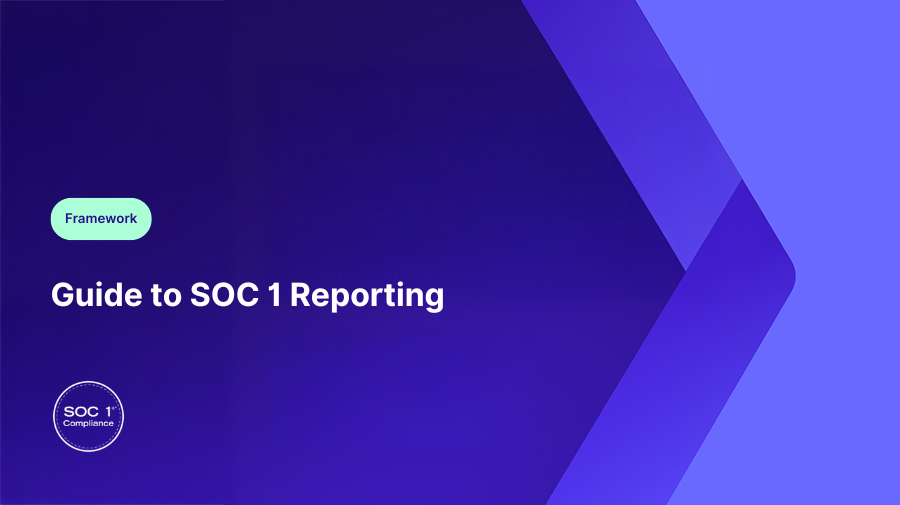
Guide to SOC 1 Reporting
For companies whose services directly impact financial reporting, a SOC 1 audit can be the first and most important proof of trust. Payroll processors, fund administrators, SaaS billing platforms; if your systems touch a client’s financial statements, auditors and regulators will want assurance. That’s what SOC 1 delivers.
Still, many teams underestimate what’s involved. Preparing for SOC 1 can quickly turn into a maze of evidence requests, control documentation, and conflicting expectations from finance and compliance stakeholders.
This guide will explain what SOC 1 is, why it matters, and how to go about preparing for Type I or Type II audits without overwhelming your team.
What is SOC 1?
SOC 1 (System and Organization Controls 1) is an assurance standard created by the American Institute of CPAs (AICPA). Its purpose is to evaluate the effectiveness of internal controls over financial reporting (ICFR).
Audience: External auditors and clients’ finance teams.
Focus: Whether your systems and processes protect the accuracy, completeness, and reliability of financial data.
Outcome: A SOC 1 report that external auditors can rely on when signing off their client’s financial statements.
SOC 1 Type I vs Type II
There are two types of SOC 1 reports, and choosing the right one depends on your business stage and client requirements:
Type I: A snapshot in time, assessing whether controls are designed properly. Useful for first-time audits or younger companies proving readiness.
Type II: Evaluates whether controls are operating effectively over a set period (typically 6–12 months). This is the gold standard most clients demand.
Pro Tip: Many organizations start with Type I to accelerate deals but quickly move to Type II to meet enterprise expectations.
Key Control Areas
SOC 1 reports focus on areas directly tied to financial reporting, including:
Transaction processing: accuracy and authorization of financial data.
Access management: ensuring only the right people can alter or view financial records. Change management: controls for changes in financial systems or applications.
Data integrity: protecting against errors, omissions, or manipulation.
Why SOC 1 Matters for Finance
SOC 1 compliance is more than an audit checkbox, it creates:
Trust in financial statements: external auditors rely on SOC 1 reports to validate accuracy.
Customer assurance: clients know their financial data is secure and correctly processed.
Regulatory alignment: helps organizations demonstrate adherence to SOX, PCAOB, and other financial reporting requirements.
Competitive edge: accelerates sales cycles with banks, payroll clients, and fund managers.
Preparing for a SOC 1 Audit
Success starts with preparation. Core steps include:
1. Define your scope: which systems and processes impact client financial reporting?
2. Document internal controls: policies, procedures, and workflows.
3. Assign clear ownership: ensure every control has a responsible owner.
4. Run a readiness assessment: identify gaps before the auditor does.
5. Automate evidence collection: reduce the burden of screenshots and spreadsheets.
6. Engage with a licensed CPA firm: select an auditor experienced in your industry.
How Complyance Streamlines SOC 1
Agentic AI for Evidence Prep: automatically collects and validates control evidence, reducing prep time by up to 60%.
Configurable for Finance-Specific Controls: adapt workflows for ICFR rather than forcing rigid templates.
Partnership and Support: expert onboarding and audit assistance so teams aren’t left alone with software.
Multi-framework scalability: align SOC 1 with SOC 2, SOX, or ISO without duplication.
Next Steps
A SOC 1 report is often the ticket to entry for working with enterprise clients in financial services. It doesn’t have to overwhelm your team. With automation, configurable workflows, and ongoing support, SOC 1 can become a source of trust and growth rather than an annual scramble.
FAQs
Who typically needs SOC 1? Vendors like payroll processors, billing platforms, and fund administrators (anyone whose systems impact financial reporting).
How often is SOC 1 required? Annually. Customers and auditors generally only accept reports issued in the last 12 months.
Is SOC 1 the same as SOX? No. SOX is a law requiring internal control over financial reporting; SOC 1 is an attestation that those controls are in place and effective.
What’s harder to achieve? Type I or Type II? Type II requires 6–12 months of evidence, making it more rigorous but also more valuable.
Can SOC 1 be combined with SOC 2? Yes. With the right platform, you can map controls across both and streamline audits.




